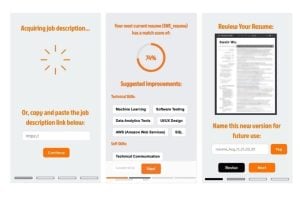
Navigating the evolving labyrinth of job application websites and automated resume scanners has become so daunting that first-time applicants and recent college grads often see very little return on hundreds of hours invested in job hunts.
Now, inspired by their own experiences with the online recruitment process, six Johns Hopkins computer science students are fighting back with an AI assistant of their own: Jobiter, an intelligent job search platform that helps find the best job opportunities tailored to users’ specific profiles.
Fourth-year undergraduates Kevin Wu, Hongyu “Eric” Zhao, and Viola Xu worked with BS/MSE student Aryavrat Gupta, rising third-year student Madhu Rajaprakash, and Jacky Wang, Engr ’25 to develop the platform as a final project for their Computer Science Innovation & Entrepreneurship course, taught by Anton Dahbura, an associate research scientist in the Department of Computer Science, and Larry Aronhime, a teaching professor in the Center for Leadership Education.
“This is an area that causes a lot of stress and ‘busywork’ for virtually all undergraduates,” explains Wu. “For example, my partner applied to over 300 open positions last fall to only secure one internship for the summer; if each application takes around 20 minutes, then that’s close to 100 hours wasted. Add in the fact that 75% of resumes are never even seen by a human, and you’ve got some pretty disheartening statistics!”
But the undergrads put their coding skills to the task. By integrating AI-powered resume and cover letter optimization, application form auto-filling, and job recommendations based on individuals’ skills and qualifications, they designed Jobiter to streamline the repetitive, time-consuming, and often demoralizing experience of navigating ATS platforms so that applicants can focus on the most important (and humane) part of the recruitment process: the interviews.
“When you start a job application online, our browser extension automatically acquires the job’s description and extracts crucial information from it,” Wu explains. The platform then uses its GPT-4o-powered resume optimization engine to analyze how well the user’s resume matches the position, providing a compatibility score and suggesting resume improvements. With one click, the optimized information auto-fills the application and it’s ready to submit.
But the development wasn’t as straightforward as the user experience is now.
“When we were implementing our auto-filler, we overcame a tremendous challenge,” Wu recalls. “Most modern ATS platforms employ React forms, which use a sophisticated structure that’s insanely difficult to manipulate; this is why a lot of the auto-fillers today don’t seem to work. Even worse, some auto-fillers might show you a screen of auto-filled content, but none of it actually gets registered with the ATS—you might be submitting an empty application without even being aware of it!”
By reverse-engineering dynamic web structures and implementing adaptive selectors, the Jobiter team was able to get around this issue in its implementation, ensuring that what you see on your screen is what will be submitted to your potential employer.
“Dehumanization is the theme in today’s recruiting process, but we aim to fight back,” Wu says. “This time, AI will be on our side.”